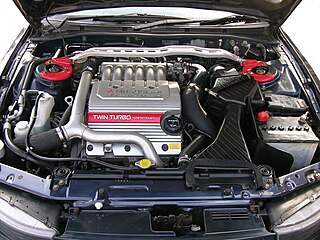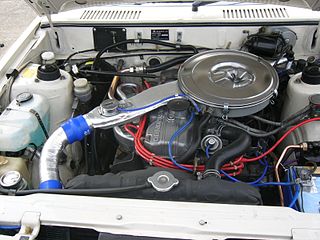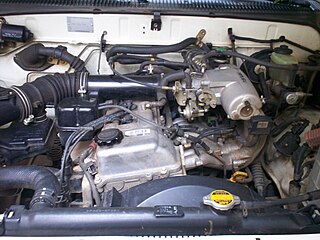
The Chrysler Hemi-6 engine is a family of inline six-cylinder petrol engines produced by Chrysler Australia in three piston displacements and multiple configurations. Hemi-6 engines were installed in Australian-market Chrysler Valiants from 1970 through 1981. It was also installed in the Valiants closely related variants, the Chrysler VIP, the Chrysler by Chrysler & the Valiant Charger.

The Jeep CJ models are a series and a range of small, open-bodied off-road vehicles and compact pickup trucks, built and sold by several successive incarnations of the Jeep automobile marque from 1945 through 1986. The 1945 Willys "Universal Jeep" was the world's first mass-produced civilian four-wheel drive car.

Mazda has a long history of building its own diesel engines, with the exception of a few units that were built under license.

The Mitsubishi 6A1 engine is a series of piston V6 engines from Mitsubishi Motors, found in their small and medium vehicles through the 1990s. They ranged from 1.6 to 2.5 L in size, and came with a variety of induction methods and cylinder head designs and configurations.

The Mitsubishi Astron or 4G5/4D5 engine, is a series of straight-four internal combustion engines first built by Mitsubishi Motors in 1972. Engine displacement ranged from 1.8 to 2.6 litres, making it one of the largest four-cylinder engines of its time.

The Mitsubishi Sirius or 4G6/4D6 engine is the name of one of Mitsubishi Motors' four series of inline-four automobile engines, along with Astron, Orion, and Saturn.

The Mitsubishi 4G9 engine is a series of straight-4 automobile engines produced by Mitsubishi Motors. All are 16-valve, and use both single- and double- overhead camshaft heads. Some feature MIVEC variable valve timing, and it was the first modern gasoline direct injection engine upon its introduction in August 1996.

The 6G7 series or Cyclone V6 engine is a series of V6 piston engines from Mitsubishi Motors. Five displacement variants were produced from 1986 to 2021, with both SOHC and DOHC, naturally aspirated and turbo charged layouts. While MIVEC variable valve timing has also been implemented in some versions the 2.5, 3.0, and 3.5 L versions were also available with gasoline direct injection. This engine has been the flagship powerplant of the company except when they briefly built a V8 in 1999–2001. The staple of their high-end sedans, it was given twin-turbos for the Mitsubishi GTO, and became the most powerful car ever built by the company at the time.

The Toyota RZ engine family is a straight-four piston engine series built in Japan. The RZ series uses a cast-iron engine block and aluminum SOHC or DOHC cylinder heads. It has electronic fuel injection (EFI), 2 or 4 valves per cylinder and features forged steel connecting rods.

The AMC straight-6 engine is a family of straight-six engines that were produced by American Motors Corporation (AMC), and used in AMC passenger cars and Jeep vehicles from 1964 through 2006. Production continued by Chrysler after it acquired AMC in 1987.

The Jeepster Commando is an automobile which was first produced by Kaiser Jeep in 1966 to compete with the International Scout, Toyota Land Cruiser and Ford Bronco. Four different models were available: a pickup truck, convertible, roadster and wagon. The Jeepster remained in production after American Motors Corporation (AMC) bought the Jeep line from Kaiser in 1970. After AMC's acquisition, the Jeepster Commando C101 steadily grew in popularity. In 1972, AMC shortened the vehicle's name to Commando C104, extended the wheelbase to 104", and changed the front-end design to accept the AMC I6 and V8 304ci, similar to the Ford Bronco. The new configuration, formerly an AMC best seller, quickly caused the line to drop in popularity and was taken out of production in 1973; it was replaced with the full size Cherokee. The Jeepster is an ancestor of the modern Jeep family produced by Chrysler.

The Hyundai Theta is a gasoline four-cylinder automobile engine family. The third all-aluminum engine of Hyundai Motor Company debuted in the fourth-generation Hyundai Sonata sedan, which was unveiled in August 2004 in South Korea. Hyundai Motor Manufacturing Alabama (HMMA) built a Theta II engine shop on the grounds of their Montgomery, Alabama automobile factory.
The Nissan H series of automobile engines is an evolution of the Nissan "R" engine which was based on the 1.5-liter, three-main bearing "G" engine used in the 1960s. Both inline-four and inline-six versions were produced. It is a pushrod OHV design with iron block, early models with an iron head, later models with aluminum head. Versions of this motor have been used in many Nissan autos and forklifts, well into the eighties and a version called H20II was in production until 2003. The SD diesels are based on this series of motors

The Willys L134 is a straight-4 flathead automobile engine that was made famous in the Willys MB and Ford GPW Jeep produced during World War II. It powered nearly all the Jeep vehicles built for the U.S. and Allies. It was later used in a variety of civilian Jeep vehicles.

The Chrysler Hemi engines, known by the trademark Hemi or HEMI, are a series of American V8 gasoline engines built by Chrysler with overhead valve hemispherical combustion chambers. Three different types of Hemi engines have been built by Chrysler for automobiles: the first from 1951 to 1958, the second from 1964 to 1971, and the third from 2003 to 2024. Although Chrysler is most identified with the use of "Hemi" as a marketing term, many other auto manufacturers have incorporated similar designs. The engine block and cylinder heads were cast and manufactured at Indianapolis Foundry.

The Jeep Tornado engine was the first post-World War II U.S.-designed mass-produced overhead cam (OHC) automobile engine. The 230.5 cu in (3.78 L) hemi-headed straight-six was introduced in mid-year 1962, and replaced the flathead "6-226" Willys Super Hurricane that was in use since 1954.

The Mitsubishi 3G8 engine is a range of three-cylinder powerplant from Mitsubishi Motors, introduced in the fifth generation of their Mitsubishi Minica kei car. In common with other contemporary engines in the class, it could be specified with many advanced technologies despite its diminutive size, including multi-valve cylinder heads and double overhead camshafts. The top-of-the-line Dangan ZZ variant was also the first kei car to benefit from turbocharging. In 1987 Mitsubishi was the first manufacturer to supercharge a kei vehicle, and in 1989 became the world's first production car to feature five valves per cylinder, ahead of similar developments by Bugatti, Audi, Ferrari and Toyota.
The E.torQ is a family of inline-4 gasoline automobile engines produced since 2010 by Fiat Chrysler Automobiles in Campo Largo, Brazil in the former Tritec factory. In November of 2022 Stellantis announced they were closing the Campo Largo factory ending production of the E.torQ 1.8 to focus on production of the newer FCA Global Small Engine.

















